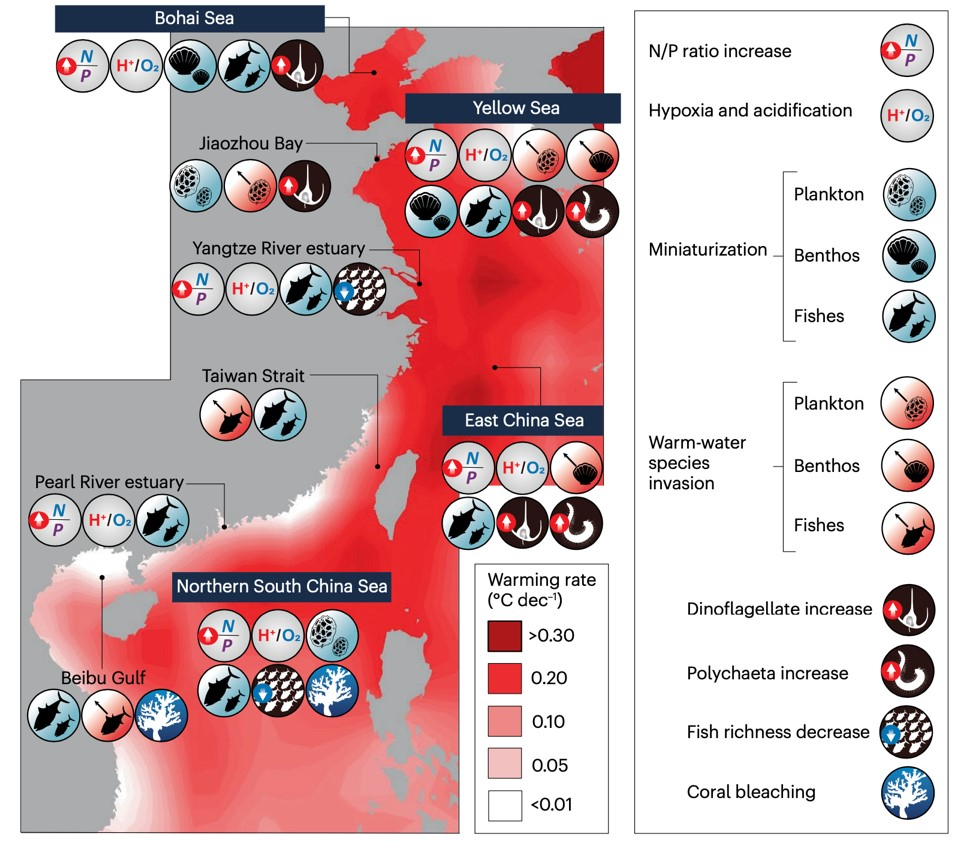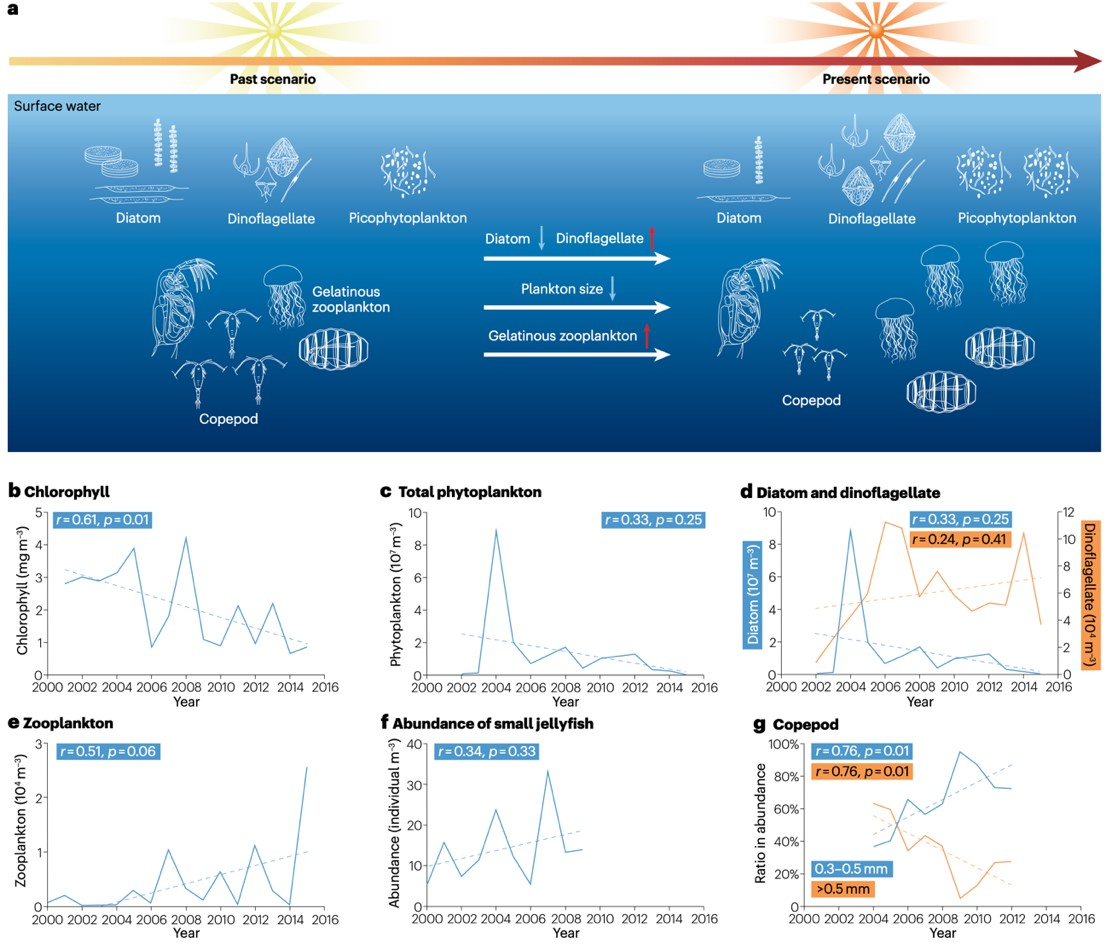Recently, Prof. WANG Fan from the Institute of Oceanology of the Chinese Academy of Sciences (IOCAS), with more than ten scientific workers in the fields of physical oceanography, marine chemistry, marine biology, marine ecology and climate in China, published a review of interdisciplinary research in seas around China in Nature Reviews Earth & Environment (NREE, with a latest impact factor of 42.1) on July 18.
The seas around China (SAC), including the Bohai Sea (BS), Yellow Sea (YS), East China Sea (ECS) and South China Sea (SCS), support for the fisheries, shipping, energy, tourism, and other industries of more than a dozen neighboring countries. Under the dual effects of human activities and climate change, SAC are undergoing multifaceted changes. Researchers synthesized scientific findings in physics, biogeochemistry, marine biology, marine ecology and other fields in recent years, integrated the latest long-term observation data, conducted multi-dimensional information mining on historical samples, reanalysis data and climate models. They expounded the evolution of SAC in the past decades systematically from an interdisciplinary perspective for the first time internationally, analyzed the characteristics and credibility of warming, marine heatwaves, circulation changes, Eutrophication, anoxic acidification, primary productivity changes, species alternation and community structure change, discuss the relationship and interaction between various phenomena deeply, and revealed the development trend of the research on the SAC towards interdisciplinary integration.
The overall warming rate of the SAC was sorted out through analyzing multiple observational data and climate models. The sea surface temperature (SST) warming has reached 0.10–0.14 °C per decade since 1950, and accelerated to 0.14–0.16 °C per decade since 1982, significantly faster than the global average. When SST trends are strongest, it reached 0.23 ± 0.08 °C per decade since 1982, 2–3 times the global average. Here, SST warming in winter is faster than that in summer owing to a weakening of the East Asian winter monsoon and enhancement of warm-water intrusion from the Kuroshio. Warming trends also increase the likelihood of extreme high temperature events - marine heatwaves (MHWs). Satellite observations since 1982 have shown that the frequency, duration, and overall intensity of MHWs in the SAC have significantly increased. These extreme events have intensively amplified the impact of climate change on the SAC, causing coral bleaching and significant losses in fisheries and aquaculture. In the past few decades, the nascent Kuroshio has been strengthening, with a decreasing invasion into the SCS in the upper layers and increasing in the deeper layers, as well as an increasing invasion into the ECS and YS. The surface anticyclone circulation in the SCS weakens in winter due to the combined effect of the Kuroshio invasion and the weakening of the monsoon. Circulation changes strengthened the spatial heterogeneity of warming and primary productivity changes by redistributing the heat and biomass.
Terrigenous nutrient input through atmospheric deposition and river and groundwater discharges has led to pervasive trend of eutrophication, with more organic matter settling to the bottom. Warming intensifies the stratification of seawater, and the degradation of organic matter in the bottom water consumes dissolved oxygen and releases carbon dioxide, resulting in an increasingly severe hypoxia and acidification. Hypoxia and acidification events in coastal seawater show a significant increasing trend of regional expansion and severity, threatening the survival and reproduction of marine organisms (especially Benthos). In addition, the growth of phytoplankton in many sea areas has a transition from nitrogen to phosphorus limitation due to the faster growth rate of inorganic nitrogen content than that of inorganic phosphorus (the ratio of nitrogen to phosphorus increases), prompting the changes in species composition of plankton communities, such as the increase of dinoflagellates and the decrease of diatoms. The SAC experiences a net carbon sink, contributed by carbon fixation flux, riverine and oceanic inputs, the biological pump and the microbial carbon pump. According to the latest estimate, the SAC can absorb 10.8 ± 23.1 Tg C year-1 through sea-air exchange. Although climate models predict that global warming will weaken carbon sinks in the marginal seas of the continental shelf, existing observations indicate that carbon sinks in the SAC have not significantly weakened.
With changes in the physical (warming, stratification strengthening, circulation planktonic, benthic, changes) and chemical (nutrient concentration and composition) backgrounds, the fish communities in the SAC have also undergone significant changes, exhibiting two distinct characteristics, miniaturization and invasion of warm-water species. The dominance of diatoms in the phytoplankton community decreases, the dominance of dinoflagellates increases, the abundance of gelatinous zooplankton such as jellyfish increases, and the size of phytoplankton and zooplankton shows a miniaturization trend. The diversity of benthos has declined as a whole, the distribution range, ecological habits and physiological characteristics of many benthos have changed significantly. The synergistic effects of warming, hypoxic acidification and eutrophication on benthos are increasingly emerging. Fish show the differential responses to climate change, with a significant increase in the proportion of warm-water species in the SAC. Although the fishery catch in the SAC over the past few decades has been increased due to the rising catch capability, climate models predict that global warming will significantly reduce the fishery catch and fishery income in the SAC.
"This study synthesizes and organizes multiple observational facts to elucidate the key role of the coupling of physical, chemical, and biological processes in the long-term evolution of the SAC," said Prof. LI Yuanlong, corresponding author of the study.
"According to the model prediction, the above change trend will continue in the future and is likely to further intensify, which will seriously affect the supporting role of the SAC on the economic development of neighboring countries and the people's Material culture life," said Prof. WANG. "To accurately project and effectively alleviate this climate pressure, the interdisciplinary research in the SAC urgently needs to be strengthened."
The study was jointly funded by the National Natural Science Foundation of China, the Chinese Academy of Sciences strategic pilot project, the key research and development project of the Ministry of Science and Technology, etc.

Fig. 1 Changes in the seas around China: warming, increased N/P (nitrogen-to-phosphorus concentration ratio), hypoxia and acidification, biological miniaturization, warm-water species invasion, dinoflagellate increase and polychaeta increase, fish richness decrease and coral bleaching.

Fig. 2 Changes in plankton communities in the seas around China. (a) A schematic of the plankton community changes. (b)-(g) Evolution of plankton derived from long-term observed data in Jiaozhou Bay.
Wang, F., Li, X., Tang, X. et al. (2023). The seas around China in a warming climate. Nat Rev Earth Environ.
(Text by LI Yuanlong)
Media Contact:
ZHANG Yiyi
Institute of Oceanology
E-mail: zhangyiyi@qdio.ac.cn
(Editor: ZHANG Yiyi)

